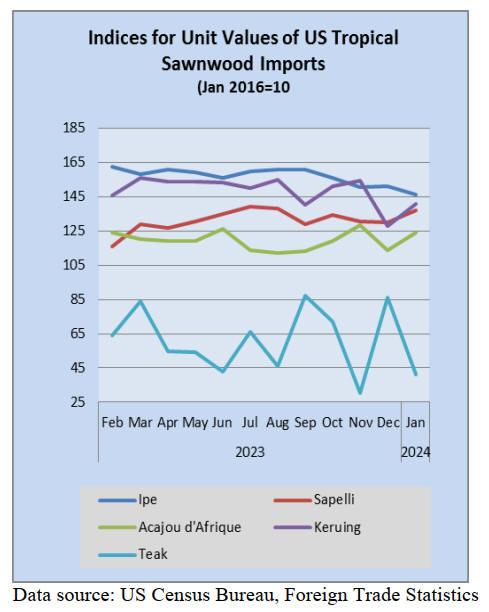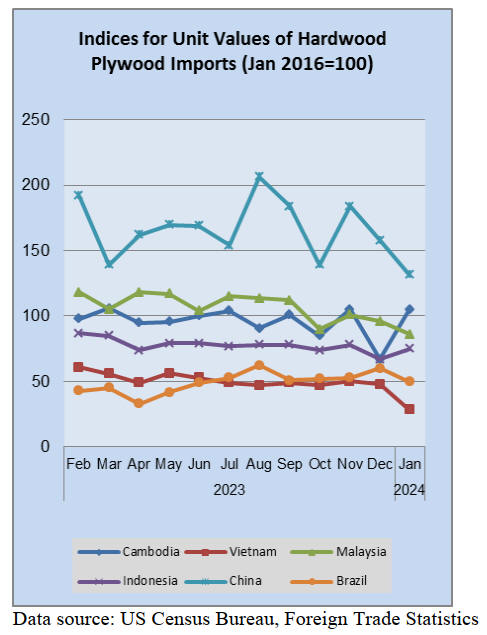|
Report from
North America
Home sales soar
Sales of previously owned homes in the US unexpectedly
soared in February to the highest level in a year, despite
surging mortgage rates that month, in a sign that buyers
are returning to the market.
Existing home sales, which make up most of the housing
market and include single-family homes, townhomes,
condominiums and co-ops, rose 9.5% in February from the
prior month to a seasonally adjusted annualised rate of
4.38 million units, the National Association of Realtors
reported. That was the second straight month of rising
sales and the largest monthly increase since February
2023.
A major driver for last month’s jump in sales was a sharp
increase in the number of homes that came to market.
Total housing inventory rose 5.9% in February from the
prior month.
“Additional housing supply is helping to satisfy market
demand,” said Lawrence Yun, NAR’s chief economist, in
a release. “Housing demand has been on a steady rise due
to population and job growth, though the actual timing of
purchases will be determined by prevailing mortgage rates
and wider inventory choices.”
In the West, existing-home sales skyrocketed 16.4% from
a month ago to an annual rate of 850,000 in February, a
decline of 1.2% from the prior year. Existing-home sales
in the South leapt 9.8% from January to an annual rate of
2.02 million in February, down 2.9% from one year
earlier. In the Midwest, existing-home sales jumped 8.4%
from one month ago to an annual rate of 1.03 million in
February, down 3.7% from the previous year. At 480,000
units, existing-home sales in the Northeast were identical
to January but down 7.7% from February 2023. It's the
fourth consecutive month that home sales in the Northeast
registered 480,000 units.
See:https://www.nar.realtor/newsroom/existing-home-sales-vaulted-9-5-in-february-largest-monthly-increase-in-a-year
Housing starts rebound
Construction of new US homes bounced back strong in
February, rising 10.7% to recover from a very weak month
in January. Despite the increase, starts are still below
December’s level.
Overall housing starts increased to an annual pace of 1.52
million units, its biggest gain in nine months according to
the Commerce Department’s monthly report. Also, the
number of housing starts in January was revised slightly
higher, to 1.37 million. Even with the upward revision,
January still saw the biggest drop, 12.3%, since May 2022.
Single-family housing starts, which account for the bulk of
homebuilding, surged 11.6% to a seasonally adjusted
annual rate of 1.129 million units last month.
That was the highest level since April 2022. Single-family
homebuilding jumped 40.2% in the Midwest and increased
16.6% in the densely populated South. It accelerated
16.4% in the Northeast but declined 15.4% in the West.
Starts for housing projects with five units or more
advanced 8.6% to a rate of 377,000 units.
The report from the Commerce Department also showed
permits for the future construction of single-family
housing units rose to more than a 1-1/2-year high in
February.
"A lack of inventory and lower borrowing costs, over
time, should be supportive of building activity," said
Rubeela Farooqi, chief US economist at High Frequency
Economics. "And a decline in mortgage rates should be
positive for sales. "
See:
https://www.census.gov/construction/nrc/current/index.html
Multi-unit starts fuel Canadian housing growth
Canadian housing starts increased by 14% in February
from the previous month as groundbreaking increased on
multiple-unit urban homes, Canadian Mortgage and
Housing Corporation (CMHC) data showed. The
seasonally adjusted annualized rate of housing starts rose
to 253,468 units from a revised 223,176 units in January,
the CMHC said. That was higher than the 230,000
expected by economists.
When looking at year-over-year figures, February's
housing starts were up 11%, with the increase driven
entirely by higher multi-unit starts (e.g., apartments and
condos) that increased 16%, while single-detached starts
were down 14%.
"As the national housing shortage continues, the focus for
developers continues to shift towards multi-unit
construction in Canada's major centers," said CMHC chief
economist Bob Dugan.
See:https://www.cmhc-schl.gc.ca/professionals/housing-markets-data-and-research/housing-data/data-tables/housing-market-data/monthly-housing-starts-construction-data-tables
US builder confidence rises for a fourth month
Builder confidence hit its highest mark since July 2023,
the National Association of Home Builders (NAHB)
reported. The NAHB said a continued lack of existing
housing inventory is still driving buyers to new home
construction. Additionally, strong demand and declining
mortgage rates are adding to the push toward new homes.
Builder confidence in the market for newly built single-
family homes climbed three points to 51 in March,
according to the latest NAHB /Wells Fargo Housing
Market Index (HMI).
The latest reading marks the fourth consecutive monthly
gain for the index. It is also the first time the sentiment
level has surpassed the breakeven point of 50 since last
July.
“Buyer demand remains brisk and we expect more
consumers to jump off the sidelines and into the
marketplace if mortgage rates continue to fall later this
year,” said NAHB Chairman Carl Harris, a custom home
builder from Kansas.
See:
https://eyeonhousing.org/2024/
Cooling of jobs market increases chance of Fed
cutting interest rates
The US economy added 275,000 jobs in February, a
stronger-than-expected gain that shows the foundation for
economic growth remains quite sturdy. February marked
the 38th consecutive month of job growth (the fifth-
longest period of employment expansion on record), and
the 25th consecutive month that the nation’s jobless rate
has been below 4%, the longest stretch in more than 50
years, BLS data shows.
Still, the report also showed that the whopping gains
initially recorded for January and December were revised
down by a combined 167,000 jobs. January’s job gains
now sit at an estimated 229,000 (down from 353,000); and
December’s job growth at 290,000 (down from 333,000).
Unemployment rose to 3.9% in February as more people
returned to the workforce.
The data may calm fears that the economy is overheated
and might increase the likelihood that the US central bank
would begin to move to cut interest rates. “I see this as
increasing the probability that the Fed acts a little bit
sooner than previously anticipated,” former St. Louis Fed
President James Bullard said. Bullard said the rise in the
unemployment rate rising to 3.9% will “get people’s
attention.” That’s the highest unemployment rate in just
over two years.
In February, employment continued to trend up in
construction (+23,000), in line with
the average monthly gain of 18,000 over the prior 12
months. Employment showed little change over the month
in construction.
See:
https://www.bls.gov/news.release/empsit.nr0.htm
Consumer sentiment stabilises
Consumers became slightly less optimistic about the
economy this month, though they continue to expect
inflation to cool further, a potential sign that price
increases will keep slowing.
The University of Michigan’s consumer sentiment index
slipped to 76.5 in March, barely below February's figure of
76.9. Americans' outlook has essentially remained fixed
since January, when it leapt higher. Sentiment is now
about halfway between its all-time low, reached in June
2022 when inflation peaked, and its pre-pandemic
averages. Americans' outlook on the economy will likely
have a significant effect on the presidential race, which
will likely focus heavily on perceptions of President Joe
Biden’s economic record.
“Consumer views have stabilized into a holding pattern,”
said UM Survey of Consumers Director Joanne Hsu.”
“Indeed, many are withholding judgment about the
trajectory of the economy, particularly in the long term,
pending the results of this November’s election.”
See:
http://www.sca.isr.umich.edu/
US manufacturing sector still shrinking
U.S. manufacturing slumped further in February, with a
measure of factory employment dropping to a seven-
month low amid declining new orders.
The Institute for Supply Management (ISM) said that its
manufacturing PMI fell to 47.8 last month from 49.1 in
January. It was the 16th straight month that the PMI
remained below 50, which indicates contraction in
manufacturing. That is the longest such stretch since the
period from August 2000 to January 2002.
However, for the first time in several months, more
industries reported growth than contraction.
“Demand is at the early stages of recovery,” said Timothy
Fiore, chairman of the survey, “as panelists’ companies
begin to prepare for expansion.”
Both the Furniture & Related Products industry and the
Wood Products industry reported contraction in February.
Furniture & Related Products also reported a decline in
new orders while Wood Products reported growth in new
orders for February.
See:https://www.msn.com/en-us/money/markets/us-manufacturing-sector-struggling-to-recover-ism/ar-BB1jb1Su


|